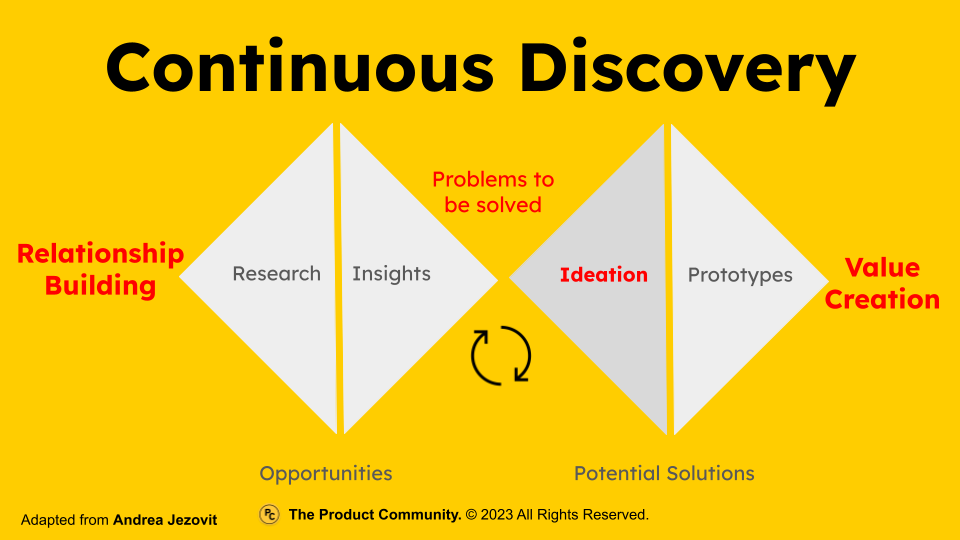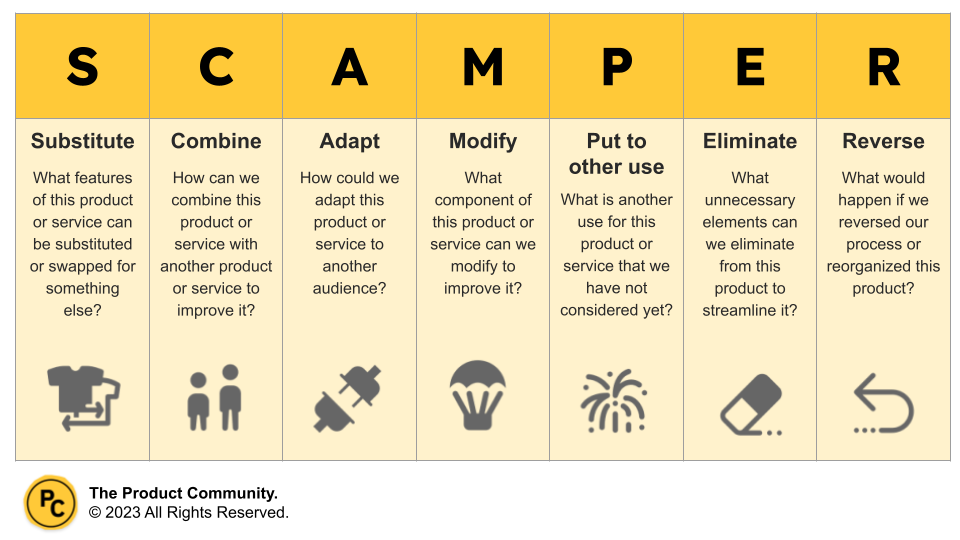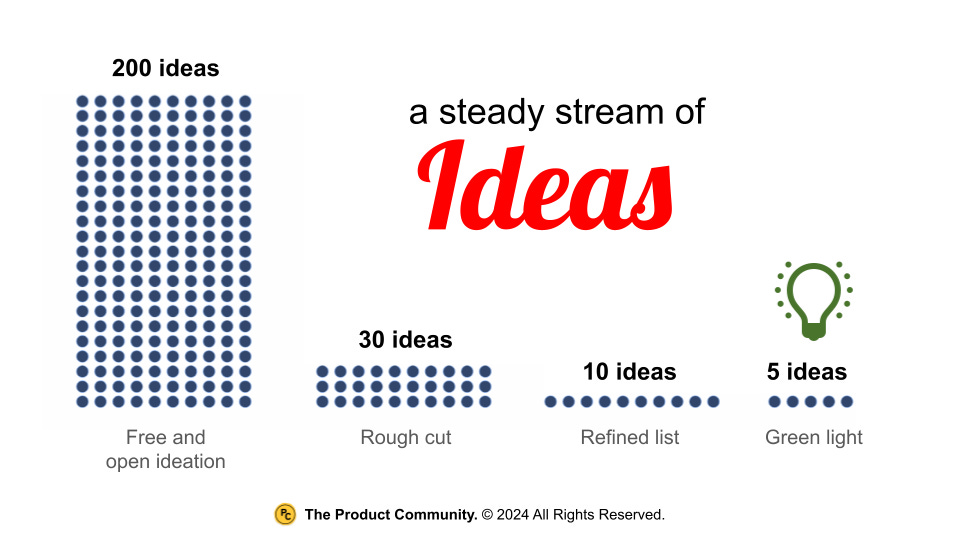Summary
In my articles Prioritizing Good Ideas and Innovation Within Constraints, I stress the importance of focus. If there’s anything to put us on the road to success – satisfied membership, diversified revenue, increased engagement – it’s focus. This article addresses focus through the lens of how to collect, manage, and green light new ideas.
It’s hard to innovate when we’re strapped for resources and don’t have a clear picture of where or how to focus. I argue that we can make focused innovation investments to help us (over time) become less resource constrained, siloed, or rushed.
Without a steady flow of managed ideas, we will suffer from flat revenue, predictable offerings, and a community forever wanting more. We will struggle to stay relevant, no less innovate.
The product community is a product development learning community designed specifically for associations.
The Importance of Idea Flow
“The truth is that for every good idea, there are a thousand bad ones. And sometimes it can be hard to tell the difference.”
Marc Randolph
Ideation – the creative process of generating, developing, and communicating ideas – is common in nearly all organizations. Much less common is determining which ones are good through a process of collecting, managing, green lighting.
Before we get into process, let’s quickly address the importance of strategy. Without a strategy to govern our actions or focus us on what’s important, all ideas look good.
An organization that struggles with idea flow probably lacks a specific, focused strategy that requires a cohesive set of choices: a winning aspiration, a clear sense of where to play and how to win, the capabilities needed to achieve success, and systems to drive superior performance.
Most associations rely on the common practice of strategic planning to create these choices. This isn’t enough. Why? Because most strategic plans are broad goals that describe a general destination; most strategic plans are not based in focused choice.
Though it may seem counterintuitive, one way to become more strategically-focused is to create a stakeholder-friendly idea flow. Involving diverse stakeholders in the idea evaluation and management process is essential for several reasons:
Diverse perspectives – Including people from various backgrounds, roles, and experiences helps provide valuable insights, identify potential blind spots, and enhance idea quality and viability.
Buy-in and ownership – Engaging stakeholders early fosters a sense of ownership and increases the likelihood of successful implementation and adoption.
Representation – Involving stakeholders who represent the interests and needs of the target audience can ensure that ideas resonate and address real problems.
Expertise and knowledge – Stakeholders with subject matter expertise can contribute valuable insights and identify potential challenges or opportunities.
Evaluating and managing new ideas is crucial for any organization that wants to stay relevant, innovative, and competitive. Let’s look at how it works.
How it Works
“Creativity is the art of possibility.”
Jeremy Utley and Perry Klebahn
I want to cover three things in this section: a process for generating ideas, baseline criteria for evaluating ideas, and initial insight into idea management.
In today’s fast-paced world, where competition is fierce and change is unpredictable, one key to success is to get better at identifying and green lighting new ideas.
The ideation process allows us to generate new ideas that can help solve problems and meet the needs of membership. It should ideally be part of a commitment to continuous discovery (see gray triangle and learn more in my article 15 Ways to Learn from Your Customers).
I recommend all associations utilize design thinking using diverse exercises to brainstorm as many new ideas as possible. One such technique called the SCAMPER Method. SCAMPER is a creative thinking technique used in product development to generate new ideas or improve on existing ones. It stands for Substitute, Combine, Adapt, Modify, Put to another use, Eliminate, and Reverse. Let's break it down, using the example of an annual conference.
Substitute — Replace a part or aspect of the existing product or service with something else. Example: Instead of a traditional conference venue, substitute it with an unconventional location, such as a park or museum, to create a unique and memorable experience.
Combine — Combine two or more existing products or experiences to create a new one. Example: Combine the annual conference with a networking event or job fair, providing attendees with opportunities for professional development and career advancement.
Adapt — Modify or adjust an existing product or service to suit a different purpose or audience. Example: Adapt the conference format to include more interactive sessions, such as workshops or design thinking ideation, catering to different learning styles and preferences.
Modify — Change or rearrange certain aspects or components of the existing product or service. Example: Modify the conference schedule to include dedicated networking breaks or concurrent sessions to better accommodate attendees' interests and schedules.
Put to another use — Find a new or alternative use for an existing product or experience. Example: Use the conference as a platform to showcase member achievements, highlight industry trends, or launch new initiatives or programs.
Eliminate — Remove or simplify certain aspects or components of the existing product. Example: Eliminate the traditional conference program and move to a fully digital social platform, reducing costs and promoting connection.
Reverse — Rearrange or reverse the order, sequence, or components of the existing product or service. Example: Instead of the traditional format where attendees go to different sessions, reverse it by having speakers rotate through different rooms, allowing attendees to stay in one place.
By using SCAMPER, we can think creatively and generate new ideas. This is one of many possibilities. Others are covered in this article.
The hardest part of idea flow isn’t generating new ideas, it’s managing them so we build an innovative and trusting culture in which the best ideas percolate to the top. Here are some example criteria and best practices for managing ideas effectively.
Align with purpose – The idea should align with the organization's strategic objectives, values, and long-term vision.
Market potential – Assess the idea's potential for attracting new members, generating revenue, or addressing a specific need within the target audience.
Feasibility – Consider the resources required (financial, human, technology) and whether the idea is realistic and achievable within the organization's constraints.
Risk assessment – Evaluate the potential risks involved, such as legal implications, reputational impact, or unintended consequences.
Uniqueness – Determine if the idea offers a unique solution or competitive edge over existing offerings or competitors.
How many ideas should we be generating and managing? As many as possible! How could it work? I recommend scheduling semi-regular sessions using a design thinking ideation process in which there is an open call for new ideas. Ideally this happens in person in a social environment where people can build off each other and create high-impact momentum.
Here are some best practices for managing ideas:
Establish a clear process – Develop a structured process for idea submission and evaluation with well-defined roles, responsibilities, and timelines.
Capture ideas in a transparent location, merge duplicate ideas regularly, and assess new ideas against current initiatives and goals.
Effective communication – Communicate regularly with stakeholders, provide updates on the progress of ideas, and seek feedback throughout the process.
Prioritization and resource allocation – Establish criteria for prioritizing and winnowing ideas down to a manageable list and allocate resources (financial, human, technological) accordingly.
Prototyping and testing – Encourage prototyping and pilot testing of promising ideas to gather real-world feedback and refine the concept before full implementation.
Continuous improvement – Regularly review and evaluate the idea management process, seeking opportunities for improvement based on lessons learned and stakeholder feedback.
Celebrate successes – Recognize and celebrate successful ideas to foster a culture of innovation and encourage continued ideation.
By implementing these best practices, we can create an environment that encourages creative thinking, values diverse perspectives, and effectively manages new ideas for the growth and success of our associations.
Becoming Innovative
“There is only one thing stronger than all the armies in the world: and that is an idea whose time has come.”
Victor Hugo
Great ideas can lead to extraordinary innovations that will excite membership, help us leapfrog competition, and remain relevant in a rapidly changing world. Bad ideas can drain morale and resources.
Properly generating and managing ideas is a core competency of a healthy association. Done well, opportunities emerge with clarity and transparency over time contributing to a culture of trustful action. If neglected or not managed well, we run the risk of creating an ‘idea death pit’ and members may go elsewhere.
Finally, it’s important to choose a few good ideas to green light and implement. Focused prioritization serves a healthy culture and motivates us to align as a team. Utilize agreed-upon criteria, but use trust to drive decisions.
Remember, product-led growth fuels connection. Join the product community and flip your destiny.
About the Author
James Young is founder and chief learning officer of the product community®. Jim is an engaging trainer and leading thinker in the worlds of associations, learning communities, and product development. Prior to starting the product community®, Jim served as Chief Learning Officer at both the American College of Chest Physicians and the Society of College and University Planning. Please contact me for a conversation: james@productcommunity.us







